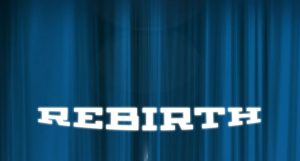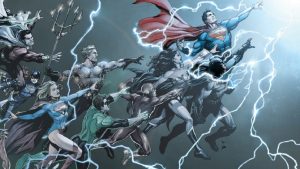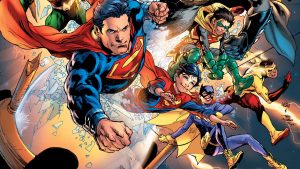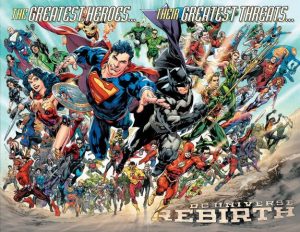Crossing Back - A Return To The DC Universe
Crisis of Infinite Rebirth-s

DC’s REBIRTH initiative is now full swing. Rebirth, conceptually, is a promise of a fundamental essence retained, but given a fresh start, whether it’s a baptism, where the soul is washed free of sin, or reincarnation, with another chance to do better. DC has a long history with resurrections and restorations of the ‘once-and-future hero’ -the quadruple return of the Supermen, Batman walking again after Bane or the death and resurrection of Oliver Queen – all presaging and shaping a mythic cycle that had become business-as-usual by the time Geoff Johns appended the word to the triumphant returns of Hal Jordan, Barry Allen and now, in its ultimate extension, the entire universe.
Following last month’s DC Universe Rebirth #1, the central thrust is known: a restoration of desuetude stories and characters and the reinstitution of superseded or abandoned relationships and legacies. This is effected through the conceit of a mysterious outside force (someone somewhere somehow doesn’t know who it is yet, right?) having stolen the heart of the DCU, a force closely correlated with the year of 1986.
The thing (okay, the other thing, but later) you absolutely need to talk about if your pitch is that 1986 was where the DCU started to go wrong? Crisis on Infinite Earths.
In stark opposition to the rebirth narrative, the Crisis story is one of the DCU going through an apocalyptic crucible, a testing cataclysm where entire worlds and individual souls are weighed. The premise? Only that which is most worthy survives, followed usually by a slew of origin stories and modernisations, where the appeal is of the DCU stepping ever closer to its purest, nigh platonic, self.
This may sound a little abstract and abstruse (“Mackenzie and Walker, abstract and abstruse? Never”, you say), but the tension between Crisis and Rebirth – between restoration and purification, between looking back and pushing forward – has been at the heart of the DCU for over thirty years now. This push-pull, perhaps, reached a peak with the New 52, and it’s no secret that the New 52 was massively divisive. Many felt that the universe they loved had been abandoned by the corporation that owned it. Others saw the relaunch as a rejuvenation – an opportunity to shift the focus away from some characters towards a more open future.
As full disclosure, five years ago, we (Mackenzie and Walker, not the royal We of Nerdspan) largely walked away from the DC universe. All dozen of our longtime readers might remember that we came into the New 52 open-minded but unsure. In our feature “Crossing Worlds”, we shared some observations on the quirks and qualities we found, even as we saw more and more of our focus and funding slide from the DC titles to Marvel, a continuity that we’d never really explored in depth before.
Our general dissatisfaction never led to a clean break– we’ve read Batman, Convergence, Midnighter, Constantine, Gotham Academy and Multiversity, to name but a few – but our deep-felt commitment to DC as a company and the DCU as a place to visit were broken.
There were a range of issues with the New 52. An over-emphasis on a certain house style for both art and storytelling. Clear failure or refusal to assist creative teams in supporting, not undercutting one another. Mandated directions to the upset of storytellers. While these were a considerable part of the problem, comics have always had periods of creative splendour and decline. There have always been autocrats and divas and wronged parties. But there was something deeper at play than the politics of the day.
As loyalists in exile, suddenly outsiders looking in, it was fascinating and sometimes heart-breaking to watch the New 52 become an ever-more polarising centre around which the storms wracking comics raged. How much should continuity be embraced? How much does carrying forward decades of stories, and characters created before living memory, function as gatekeeping? How much can iconic characters change, and still be themselves? How do you best diversify creative teams? Do the people in charge even want to? In a world of diminishing market share, what obligation does a corporate IP holder have to maximise sales over producing representative – or even qualitatively superior – art? Must great art take risks, or do caretakers of communally beloved characters have an obligation to be conservative?
These are corporate, artistic and social questions that a linewide issue relaunch can’t answer. Much of the debate fundamentally stems from a debate about what the DC Universe is. The New 52 poses the question that if the setting is new, and the characters are new (even if they use old labels) does the DC Universe remain? If the handle and the blade are replaced, is it still the axe of your grandfather?
This question innately requires considerations of representation and ownership. Often, the debate will centre around personal perceptions of the quality of stories, but this is ultimately a question relatively beyond the control of the company or even the creators. Let us accept as an article of faith that they’re all trying to produce what they think are the best stories. Let us accept that good and bad stories existed before and after Flashpoint, and that they will continue to do so post-Rebirth.
What is, then, left for DC to “fix” on a linewide basis? What decisions must, perforce, be made for the whole?
Connectivity

DC has spent a lot of time and a lot of marketing money emphasising as its strongest attribute is the sense of legacy and history that made up the universe. That sense of both reification and evolution gave it both a distinct personality, irreplaceable within an ab initio superhero setting, and a sense of scope, transitioning that proliferation of titles from a liability into an asset. For a shining period, Jay Garrick to Barry Allen to Wally West to Bart Allen felt like a genuine progression, a stretching tradition to be both innovated and maintained. This gave decision-making consequential weight, because even though things were rarely ever taken away (what with revolving door deaths and mysterious reappearances), things could always be added.
The web of relationships was only ever expanding, even as central characters provided its core. To take some straightforward examples, Jaime Reyes wasn’t just a character called the Blue Beetle. He was in the shadow of Ted Kord, a painful yet hopeful reminder to Booster Gold, a sparring foe of Guy Gardner, a secret weapon to Batman, and a boyfriend to Traci 13. Without Batman there was no Commissioner Gordon, no Major Crimes, thus no Renee Montoya, and from there no relationship with the Question or Batwoman. No Young Justice without not just Wonder Girl and Superboy, but Arrowette and Empress and Secret too.
But there is an argument that this connective tissue, this distinctive aspect, hits up hard against diminishing returns. Rebirth has chosen, in a very real sense, to go back to the best of all possible DCUs – a world with a JLA in their prime, an older and a few younger generations behind, and endless possibilities ahead. But at about four generations, as you find with the Flash and Bat families, you reach the hard cap of what you can reasonably add without taking away. You can tweak around the edges – such as the JSA in a Ragnarok dimension, or Marvel’s Captain America in the ice, or Batman’s clone machine giving him a younger body – but you can’t do that with every character every time. You can drag it out by never pinning explicit ages on anyone, by placing flashbacks in a nebulous beforehand, but that sense of scope and personality provided by continuity relies at some point on specificity. If a Bruce Wayne in his prime is the best of all possible Batmen, if Jay Garrick is not to fade away, then DC has more than once put their toes to the precipice before pulling back, the fires of Crisis purging away every threat to the incumbent protagonists. Naturalistic progression loses out to protecting iconography every time.
There are advocates, we know, who take this as an argument for jettisoning of continuity altogether, whose vision of the future of superhero comics are as a loosely connected series of out-of-continuity Elseworlds, with certain base assumptions but otherwise unlimited creative freedom. Regardless of whether this is formalised through something like Grant Morisson’s Hypertime (that guy loves bold ontological theories that accept and address publishing realities) or is an informal agreement about the assumed base of knowledge, those who champion this creator and fan freedom see it as the only way ahead.
We’re not those guys. If the DC Universe isn’t meant to be just a publishing line of superhero stories, but is meant to be a universe, then these relationships do matter. One of the things that superhero comics, perhaps uniquely amongst genres across media, does really well is provided that sense of overall universe.
To quote from our third Crossing Worlds piece:
Despite diminishing readerships, the Big Two comic universes are something special and important to our culture. Only daytime soap operas and long-running sci-fi settings like Star Trek and Doctor Who have comparably interlocking, eternal narrative structures, and they each draw from a smaller box of toys to build their stories. Only a comics fan can examine decades of character growth and development across all of time and space, watching threads weave in and out of the stories of a thousand other heroes. With the long literary legacy of valuing crossovers and expanding continuities, these features make the settings valuable unto themselves, and heroes representing different narrative and cultural legacies serve to expand and support this setting.
Continuity can be challenging, but in the hands of skilled writers and interested parties not that challenging, and in the right circumstances can yield much greater rewards than its detriments. The DC Universe becomes more than a brand, it becomes a place you can visit.
Inclusivity

The challenge in making the DCU a place you can visit is to ensure it is a place anyone can visit. The last thing comics readers need to see themselves as is as the invitees to Tomorrowland, a self-proclaimed elite of “the geniuses, the artists, the scientists, the smartest, most creative people in the world… go to a place free from politics and bureaucracy, distractions, greed – a secret place where they could build whatever they were crazy enough to imagine…”, not that this sort of poisonous thought would ever spread.
As the New 52 wore on (and the overall demography of comics continued its inexorable and, frankly, desirable change), the issue of inclusiveness moved evermore to the forefront. Part of the promise of the New 52 was that it could open up emphasis and importance to characters of different races, genders and sexualities, the characters the least well well-served in the retrograde Silver Age from which most of DC’s unaging heavy-hitters were drawn. After some initial promise and then a marked retreat, this was sought to be addressed in the “DC: YOU” initiative: an ultimately late-stage attempt to address an imbalance in the make-up of DC’s creative, editorial and administrative teams and in the books that they were producing, trending towards a more inclusive whole. Depending on who you ask, the initiative was either a failure, or cut down in its prime before it had a chance to bloom.
Inclusivity (embracing here diversity, representation, participation and empathy) is a vital metric by which a form of quality can be assessed, because unlike other forms of qualitative testing, it can be objectively measured. You can count (and people do) women, LGBTQ people, people of colour, both in stories and on creative teams. You can determine by reference to an external source whether or not people are included. The mere presence of representatives isn’t the be all and end all, of course, further analysis can then indicate how the characters are treated. Nor is it a matter of suggesting that a creative team with a more restrictive demographic cannot write inclusive books. Everyone will have their own examples of where this isn’t the case.
Representation nonetheless is a net good. A lot of the debate around discussing that issue seems to focus on “can’t you talk about quality instead of politics”, but as we’ve said before and will say again: representation is an issue of quality before it is one of politics. If there are two otherwise equally well executed books, and one has representation that means that more people can connect with and enjoy the book, and the other doesn’t, the representational book is a better book. That’s just maths. (It’s not the only net good, of course. A book can be inclusive, and still be a bad book. The characters can be well conceived, put poorly executed. The plot can have massive holes, the tone can otherwise be offensive. Something of the storytelling can be lost.)
The challenge with the DCU is that continuity ensures some very critical decisions regarding inclusivity are made before you get to the individual books. If the JLA is ideally the Big Seven, then six out of seven of the most important characters are men. If the young never reach maturation, but representation is limited to new characters, then diversity will be implicitly associated with naivety, irrationality and incomplete growth. Ultimately, a shared space requires the net good of representation be included in every level of decision making.
Walking Forward, Looking Back

Ultimately, the recent years for DC have attempted to reconcile two, perhaps fundamentally opposed, definitions of the “real”: a world that is:
- Internally consistent – reflecting their own rich narrative history, but where all the most important characters are white, heterosexual, cisgendered men of a different era; or
- Externally consistent, reflecting the truth of the age in which we live, speaking to our lived experience as readers, but requiring the abandonment, reshuffling, recasting or rebooting of characters from that earlier age to fit the world as it is.
Attempts have pivoted back and forth between both aspects, with advocates for both camps agitating for their own vision of what would make the DC universe more “real”.
Rebirth, then, is dogged with complexity. For those who appreciated the new, and who were enthused about the direction of the last five years, it is easy to see how they might feel abandoned by DC in the wake of a return to an emphasis on the DCU of yesteryear. For those who had missed the old, Rebirth represents an opportunity to restore a sense of cohesion and history that even those who are fans of the storytelling of the New 52 would have to concede the universe has recently lacked.
The trick to navigating that complexity in any piece like this is that it’s vital we don’t let our fandom get in the way of an overall assessment of the books. We’re white, and straight and not as young as we used to be. We learned to love comics in a much less representative era. It means a lot to us that say, Green Arrow and Black Canary are a thing again, or that Greg Rucka has a chance to right the wrongs of an all too sadly aborted earlier Wonder Woman run. We’ve been saying for a while that the pitch of Rebirth has been precision adapted to bring us back. They’re playing our song.
But the fact that some decisions might make us catered for doesn’t make them the right decisions. We care about diverse books more than we care about our own particular preferences being sated. We have to, because as we said before, representation is a measurable metric of quality (and, as should go without saying, the right thing to do).
The only way that DC can truly get this right, is to finally square the circle. If they want to actually grow and improve their books, they can’t just return to the old. There’s too much water under the bridge. But we do feel that it is important to restore the relationships between the Big Seven (first and foremost) and the rest of the world, because by gradual evolution those relationships have become the cornerstone of the richer web of relationships that makes the DC Universe something unique.
Rebirth, then, positions itself (remember the “it’s not a reboot, and never was” marketing slogan) as an attempt to revitalise DC as a broad church, and in so doing make it broader than it has ever been before. Nothing is taken, they say but things are added back. DC Universe Rebirth #1 sought to convey this with the inclusion of Wally West, perhaps the most beloved emblem of the discarded era, but also made sure to include Wallace West, the new Kid Flash (who happens to be a person of colour). At the same time, it kills off a character emblematic of the New 52 (albeit, in our view, a terrible one), and blames a lot of its own mistakes on earlier forces (in particular one creator whom the company NOTORIOUSLY treated – and continues to treat, even in this very story, – viciously).
How much can we trust them? Robert called Rebirth a delicious meal, made to his exact tastes, cooked in a suspiciously dirty restaurant. Dave said that Rebirth is like being in a relationship where they say they’ll do better, but won’t apologise, and clearly are lining up to trip into the mistake again through misdiagnosis.
Ascribing overall interpersonal motivations to a corporation is notoriously messy. But attempting to simply excuse the sins of the past on any particular figure (no matter how influential) is not the answer, whether that be by the company in attempting to shift blame, or by the audience in attempting to determine a source for all mistakes.
Ultimately, this has much to say about the overall myth of course correction. One of the great unspoken shibboleths of mainstream comics appears to be an attempt to crack a philosopher’s stone, a comic book that will please everybody.
It can’t be done.
You can get comics that will please more people rather than less, but any attempt at “course correction” fundamentally assumes a “one true way” to do things that’s never going to be found. People are different, they want different things.
‘New’ isn’t the same as modern. The first step to stable quality and respect is accepting that the DC Universe has a lot of interested parties to take care of. It’s a responsibility to take no sides, seek synergies, try new things, respect the entire past and tell new stories with the old characters and old stories with new characters.
Rebirth, it should be noted, isn’t set up to be as retrograde as some critics seem to have made it out to be. It’s better that the Amazons aren’t habitual rapists. The Batgirl with the Birds of Prey still has her Burnside look on the covers. Batwoman training up a team of diverse (and fan-favourite) Gothamites is a great plan. It’s hard to imagine what Christopher Priest is going to bring to Deathstroke. Jackson Hyde as an out and proud gay man of colour is an excellent idea.
But as with every major decision, it can be hard not to prosecute old wars, because wars leave scars. DC can promise whatever syncretic avenues it likes, and people may not believe them because they’ve been burned before – and some of those previously burned may have a hard time not pushing their own visions instead of a more perfect union.
That’s not the fault of any creator, or any fan. It’s not their job not to have opinions or preferences or personal stakes – they should. Synthesis is the job of the company. That’s their role, more than telling particular stories or getting any One True Way right. (Their other role is to manage internal disasters, like the employment of known sexual harassers, or ensuring that their hiring polices reflect the diversity of talent that’s out there, in such a way as not to be morally bankrupt or to betray their audience, who, after all, are seeking to experience characters who fundamentally arc towards the good, but that’s another column). They have to embrace the multitude.
That’s what they’ve tried to promise to do for the DC Universe, and they’ve embraced enough of their vital relationship ethos to lure us back to the fold (along with some vitally exciting creative teams). The only way to see if they can meet that promise is by trying the books.
And that’s what we’re going to do. Over the coming weeks, you’ll be seeing a lot of new DC reviews on Nerdspan, through various sources, we have no doubt. We’ll be checking in with the DCU too, and giving our initial impressions of whether or not there really are brighter days ahead for everyone.
This is… Crossing Back.
Next Time on Crossing Back…The Trinity


